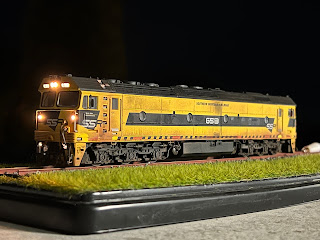Firstly, welcome back to the blog and welcome to 2025.
Late in 2024 Australian Railway Models released their Oil Burning D55. Prior to this, they had released what was actually a quite nice representation of the as built NSWGR K class (D55 pre reclassification) and for what they are at their low price tag of $300, a decent model.
With the arrival of the oil burner 55, it brought to the market an affordable way to get a 55 in their later life form, and subsequently I purchased one.
Looking overall at the model, I wasn’t a fan of the headlight, and everything else was rather bearable so the idea came together of modelling the 55 as a coal burner, and with a turret tender as well.
Initially the turret tender was purchased off eBay from Shaun Davies, his tender comes minus bogies so these were purchased from Stephen Johnson Models. Both items being relatively easy to assemble, the bogies being more of a challenge because I have never built bogies before in a fold and solder format.
With some additions to the chassis to not foul the SJM bogies in the way of adding material to the bolsters on the tender, attention was turned to the locomotive.
The first alteration being the fitting of the lubrication lines from the cab to the cylinders, compressor and turbo generator. These were made out of some flexible wire sourced from Spotlight and they solder really easily. The ‘T’ piece in the lube lines is just 0.4mm wire with the wire soldered directly to it. Brackets for the lines were created from receipt paper cut thinly and glued in place, the downside here for me was my superglue had decided to cure whilst in my shed and has well, left a few distasteful glue marks on the engine.
I replaced the headlight with an Ozzy Brass product, which was rather simple to do. I did however go to the effort of drilling out for an eventual surface mount diode, and may yet make the marker lights operable on the engine as I think that would be quite neat.
From that point, the original chimney was altered with the removal of the chimney cap and oil burning controls from the fireman’s side.
Painted and weathered using a mixture of SMS and Outlaw paints, some powders and Testors dullcote.
I’m overall impressed with the general appearance of the model, however I think the motor may be a weak link and the pickups aren’t the greatest. For DCC the engine will have pickups fitted to the tender, and some other small trinkets to hopefully improve running.
I’m looking forward to attempting to convert one into a D53, as I think that would be something useful for my collection.
Anyway, thanks for the rambles. Cheers.

































